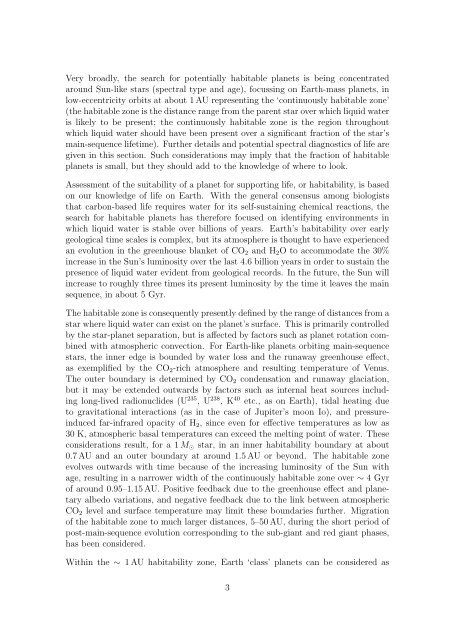Report - School of Physics
Report - School of Physics
Report - School of Physics
You also want an ePaper? Increase the reach of your titles
YUMPU automatically turns print PDFs into web optimized ePapers that Google loves.
Very broadly, the search for potentially habitable planets is being concentrated<br />
around Sun-like stars (spectral type and age), focussing on Earth-mass planets, in<br />
low-eccentricity orbits at about 1 AU representing the ‘continuously habitable zone’<br />
(the habitable zone is the distance range from the parent star over which liquid water<br />
is likely to be present; the continuously habitable zone is the region throughout<br />
which liquid water should have been present over a significant fraction <strong>of</strong> the star’s<br />
main-sequence lifetime). Further details and potential spectral diagnostics <strong>of</strong> life are<br />
given in this section. Such considerations may imply that the fraction <strong>of</strong> habitable<br />
planets is small, but they should add to the knowledge <strong>of</strong> where to look.<br />
Assessment <strong>of</strong> the suitability <strong>of</strong> a planet for supporting life, or habitability, is based<br />
on our knowledge <strong>of</strong> life on Earth. With the general consensus among biologists<br />
that carbon-based life requires water for its self-sustaining chemical reactions, the<br />
search for habitable planets has therefore focused on identifying environments in<br />
which liquid water is stable over billions <strong>of</strong> years. Earth’s habitability over early<br />
geological time scales is complex, but its atmosphere is thought to have experienced<br />
an evolution in the greenhouse blanket <strong>of</strong> CO 2 and H 2 O to accommodate the 30%<br />
increase in the Sun’s luminosity over the last 4.6 billion years in order to sustain the<br />
presence <strong>of</strong> liquid water evident from geological records. In the future, the Sun will<br />
increase to roughly three times its present luminosity by the time it leaves the main<br />
sequence, in about 5 Gyr.<br />
The habitable zone is consequently presently defined by the range <strong>of</strong> distances from a<br />
star where liquid water can exist on the planet’s surface. This is primarily controlled<br />
by the star-planet separation, but is affected by factors such as planet rotation combined<br />
with atmospheric convection. For Earth-like planets orbiting main-sequence<br />
stars, the inner edge is bounded by water loss and the runaway greenhouse effect,<br />
as exemplified by the CO 2 -rich atmosphere and resulting temperature <strong>of</strong> Venus.<br />
The outer boundary is determined by CO 2 condensation and runaway glaciation,<br />
but it may be extended outwards by factors such as internal heat sources including<br />
long-lived radionuclides (U 235 , U 238 , K 40 etc., as on Earth), tidal heating due<br />
to gravitational interactions (as in the case <strong>of</strong> Jupiter’s moon Io), and pressureinduced<br />
far-infrared opacity <strong>of</strong> H 2 , since even for effective temperatures as low as<br />
30 K, atmospheric basal temperatures can exceed the melting point <strong>of</strong> water. These<br />
considerations result, for a 1 M ⊙ star, in an inner habitability boundary at about<br />
0.7 AU and an outer boundary at around 1.5 AU or beyond. The habitable zone<br />
evolves outwards with time because <strong>of</strong> the increasing luminosity <strong>of</strong> the Sun with<br />
age, resulting in a narrower width <strong>of</strong> the continuously habitable zone over ∼ 4 Gyr<br />
<strong>of</strong> around 0.95–1.15 AU. Positive feedback due to the greenhouse effect and planetary<br />
albedo variations, and negative feedback due to the link between atmospheric<br />
CO 2 level and surface temperature may limit these boundaries further. Migration<br />
<strong>of</strong> the habitable zone to much larger distances, 5–50 AU, during the short period <strong>of</strong><br />
post-main-sequence evolution corresponding to the sub-giant and red giant phases,<br />
has been considered.<br />
Within the ∼ 1 AU habitability zone, Earth ‘class’ planets can be considered as<br />
3
















